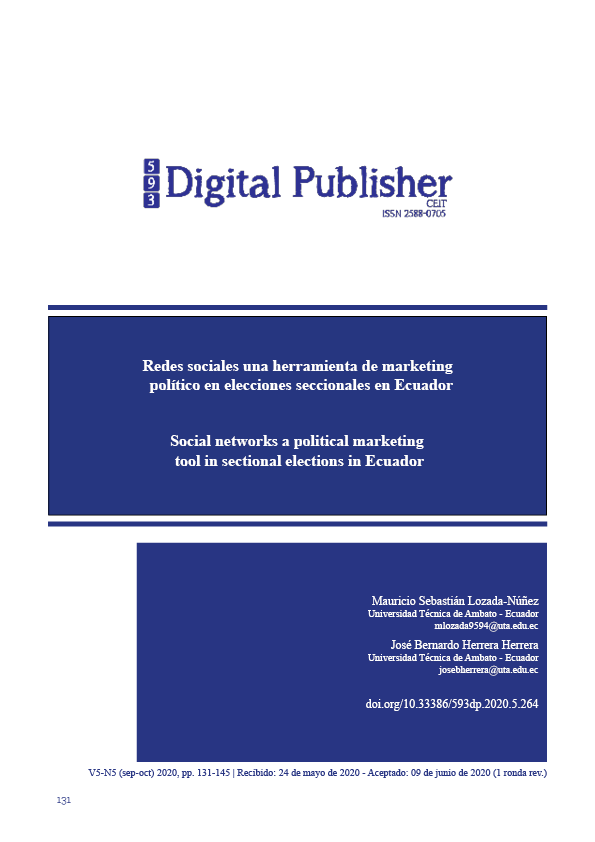Social networks a political marketing tool in sectional elections in Ecuador
Main Article Content
Abstract
The objective of this research is to carry out a comparative analysis of social networks as a tool of political marketing in the elections of mayor, prefect and councilors of the province of Tungurahua-Ecuador. The problem that is identified is that candidates for political positions do not have planning for social networks and do so empirically. It is a descriptive study that is based on theoretical elements based on bibliographic analysis, through the analysis-synthesis method that allows conclusions to be reached. In addition, the Karma and Foller Me Fanpage tool was used to monitor each candidate's Facebook and Twitter social network. Among the results are the main findings in interaction and engagement between candidates and citizens. The conclusions of the study show that social networks are of the utmost importance for the political sphere to generate approchement with citizens and empathy with their campaign proposals.
Downloads
Article Details
1. Derechos de autor
Las obras que se publican en 593 Digital Publisher CEIT están sujetas a los siguientes términos:
1.1. 593 Digital Publisher CEIT, conserva los derechos patrimoniales (copyright) de las obras publicadas, favorece y permite la reutilización de las mismas bajo la licencia Licencia Creative Commons 4.0 de Reconocimiento-NoComercial-CompartirIgual 4.0, por lo cual se pueden copiar, usar, difundir, transmitir y exponer públicamente, siempre que:
1.1.a. Se cite la autoría y fuente original de su publicación (revista, editorial, URL).
1.1.b. No se usen para fines comerciales u onerosos.
1.1.c. Se mencione la existencia y especificaciones de esta licencia de uso.
References
Afrina, Y., Tasneem, S., & Fatema, K. (2015). Effectiveness of digital marketing in the challenging age: an empirical study. International Journal of Management Science And Business Administration, 1(5), 69-80.
Agreda, L. (2016). Análisis de la estrategia de marketing digital mediante herramientas de analítica web. Investigation Research Review, 7, 81-97.
Albarrán, E., & Salzman, R. (2011). News media consumption in Latin America: Who does It? Journal of Spanish Language Media, 4, 23-39.
Almuiñas, J., González, F., & Morales, D. (2013). El control estratégico: una perspectiva en construcción en las instituciones de educación superior. España: Congreso Universidad.
Álvarez, F. (2007). Planificación estratégica de marketing. Perspectivas, 67-104.
Ancu, M. (2009). Myspace politics: uses and gratifications of befriending candidates. Journal of Broadcasting & Electronic Media, 53(4), 567–583. doi:https://doi.org/doi:10.1080/08838150903333064
Ballesteros, P., González, M., & Fernández, D. (2012). Human resource allocation management in multiple projects using sociometric techniques. International Journal of Project Management, 901–913.
Blank, S., & Dorf, B. (2012). The startup owner’s manual: the step-by-step guide for building a great company. Chicago: K&S Ranch.
Blythe, J., & Jane, M. (2019). Essentials of marketing. Estados Unidos: Pearson.
Booth, J., & Seligson, M. (2009). The legitimacy puzzle in Latin America: political support and democracy in eight nations (Vol. 3). Inglaterra: Cambridge University Press.
Burke, S., Stagl, K., Cameron, K., Goodwin, G., Salas, E., & Halpin, S. (2006). What type of leadership behaviors are functional in teams? A meta-analysis. The Leadership Quarterly, 17(3), 288–307.
Burrow, J., & Fowler, A. (2015). Marketing. Estados Unidos: Cengage Learning.
Cai, L., Jing, Y., Qi, Q., & Xu, X. (2018). A comprehensive study on smart beta strategies in the a-share market. Applied Economics, 1-10. doi:https://doi.org/10.1080/00036846.2018.1489113
Camps, A. (2019). Out of the dominant political agenda: translation and interpreting networks for social activism. Transfer, 9-23.
Etzel, M., & Walker, B. (2017). Fundamentos de marketing. México: McGraw-Hill.
Eveland, W., Morey, A., & Hutchens, M. (2011). Beyond deliberation: new directions for the study of informal political conversation from a communication perspective. Journal of Communication, 61, 1082–1103. doi:https://doi.org/10.1111/j.1
Ford, R., & Piccolo, R. (2016). Strategies for building effective virtual teams: trust is key. Business Horizons, 10, 25-34. doi:http://dx.doi.org/10.1016/j.bushor.2016.08.009
García, B. (2016). Cibercultura, tic y redes sociales: nuevas formas de comunicación para las familias. Revista de Medios y Educación, 195-206.
Gómez, C., & Mejía, J. (2012). La gestión del Marketing que conecta con los sentidos. Revista EAN, 47-78.
González, N. (2015). Qué entendemos por usuario como centro del servicio. Estrategia y táctica en marketing. El profesional de la información, 24(1), 9.
Greenberg, P. (2010). Customer relationship management, social CRM strategies, tools, and techniques for engaging your customers, at the speed of light. Washington: McGraw-Hill.
Gronroos, C. (1993). Toward a third phase in service quality research: challenges and future directions. Advances in Services Marketing and Management, 49–64.
Hill, R. (2016). What’s love got to do with it? Examining millennials’ attitudes towards relationships and intimacy. Alabama Argicultural and Mechanical University, 7-11.
Jenkins, H. (2008). Convergence cultura: la cultura de la convergencia de los medios de comunicación. México: Paidós Ibérica.
Jeong, O., & Lee, S. (2010). On social web sites. Information Systems, 35, 215-236.
Kim, J., Yoo, F., & Zuñiga, G. (2017). Cognitive benefits for senders: antecedents and effects of political expression on social media. Journalism & Mass Communication Quarterly, 94(1), 17–37.
Kumar, M., & Kumar, U. (2004). A conceptual framework for the development of a service delivery strategy for industrial systems and products. Journal of Business & Industrial Marketing, 19, 310–319.
Lyons, J., & Sokhey, A. (2014). Emotion, motivation, and social information seeking about politics. Political Communication, 31, 237-258. doi:https://doi.org/10.1080/10584609.2013.828138
Manzano, B. (2015). The development ofthe digital competence in the Spanish basiceducational law. Opción, 828-853.
Moreira, W. (2019). Análise sobre o desempenho de evaristo costa em campanhas publicitárias por meio do Instagram. Temática, 15(3), 23-45. doi:https://doi.org/10.22478/ufpb.1807-8931.2019v15n3.44975
Norris, P. (2000). A virtuous circle: political communications in postindustrial societies. Estados Unidos: Cambridge University Press.
Salzman, R. (2015). Understanding social media use in Latin America . Palabra Clave, 18(3), 842-858. doi:https://doi.org/doi:10.5294/pacla.2015.18.3.9
Sheldon, P., & Bryant, K. (2016). Instagram: motives for its use and relationship to narcissism and contextual age. Computers in Human Behavior, 58, 89-97. doi:http://dx.doi.org/10.1016/j.chb.2015.12.059
Sheng, Q., & Xian, G. (2008). Developing a framework for business intelligence systems based on rosettaNet frame. 2008 4th International Conference on Wireless Communications, Networking and Mobile Computing, 1-4. doi:https://doi.org/10.1109/WiCom.2008.2130
Stieglitz, S., & Dang, L. (2013). Social media and political communication: a social media analytics framework. Social Network Analysis and Mining, 3(4), 1277-1291. doi:https://doi.org/10.1007/s13278-012-0079-3
Zuñiga, H. (2018). Medios sociales y democracia. El Profesional de la Información, 27(6), 1172.



